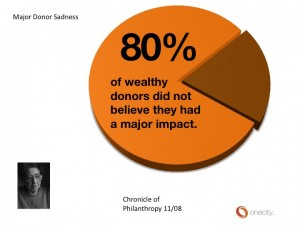One of my favorite presentations to give is “Aunt Ruby’s Rules on Nonprofit Branding.” I won’t try to describe it in detail, but it deals with what I consider the current realities and opportunities for nonprofit leaders all in the context of how my very proper Aunt Ruby would say it.
The material is the hottest and most recent thinking I can find. But two slides that I love to show are from a pretty old study.
Here are the slides (that’s Aunt Ruby in the lower left of the slide).


I’ve had the opportunity to drop this presentation on MBA classes and groups of NPO professionals. While the study referenced in these two slides stands out because they’re much older than the other material, I always tell the groups: “The situation hasn’t changed.”
Here’s what I find fascinating. The MBA students are typically incensed, shocked and doubtful. I usually get a round of comments that cast doubt on the conclusions because of the age of the report. If it’s old data, it must be wrong.
The NPO pros are usually sad and resigned. The practitioners understand. They’re not happy about it, but few doubt it.
So assuming there hasn’t been a watershed change in the way NPOs operate or the way Major Donors feel, right now there are major donors in your file who don’t feel like they are making a difference in your work. And they may easily be wooed away by another NPO who help them understand the difference they are making in the world (not in your budget but the “why” they are giving.)
Major donors don’t leave because they’re mad.
Major donors usually won’t even tell you when they’re drifting.
Major donors usually are giving to a number of different organizations…that means someone else may be helping them understand how important they are.
Right now, before you get into the 4th Quarter insanity…help some of your major donors understand the difference they are making. Don’t ask for money. Don’t even hint at future giving. Tell ‘em how they’ve changed the world (or better yet, how they’ve impacted a single person’s life) through their thoughtful, generous giving.
They’ll love it. They’ll know they are important to your cause. And you’ll be glad they understand.
So what do you think? Do major donors wonder if they’re important to your organization? Do you think major donors understand how they fit into your organization’s work? I’d love to know what you think.
![]()
Steve Thomas
Partner, Oneicity
(photo credits: Steve Thomas)

